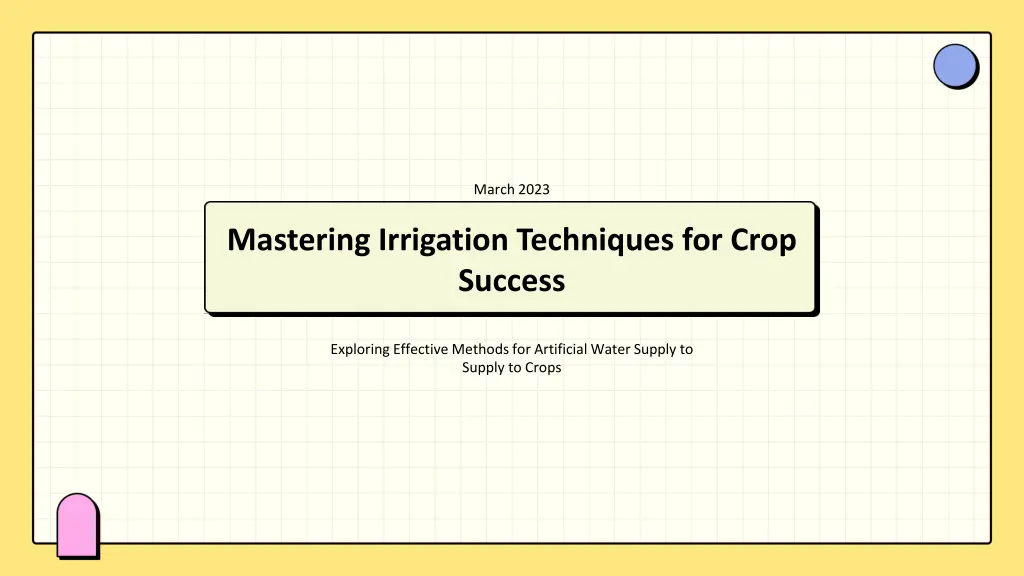
Effective Irrigation Techniques for Crop Success in Agriculture
Explore mastering irrigation methods for optimal crop growth and yield. Discover benefits of drip irrigation, surface irrigation, and sprinkler systems. Learn how to manage water efficiently for sustainable farming practices and global food security. Gain insights into different irrigation techniques tailored to specific crops, soil types, and water availability.
Download Presentation

Please find below an Image/Link to download the presentation.
The content on the website is provided AS IS for your information and personal use only. It may not be sold, licensed, or shared on other websites without obtaining consent from the author. If you encounter any issues during the download, it is possible that the publisher has removed the file from their server.
You are allowed to download the files provided on this website for personal or commercial use, subject to the condition that they are used lawfully. All files are the property of their respective owners.
The content on the website is provided AS IS for your information and personal use only. It may not be sold, licensed, or shared on other websites without obtaining consent from the author.
E N D
Presentation Transcript
March 2023 Mastering Irrigation Techniques for Crop Success Exploring Effective Methods for Artificial Water Supply to Supply to Crops
Table of Contents 5 Benefits of Drip Irrigation 1 Mastering Irrigation Techniques 2 Exploring Types of Irrigation Surface Irrigation Explained 3 Understanding Sprinkler Irrigation Systems 4
Mastering Irrigation Techniques 1. Irrigation plays a crucial role in agriculture, providing essential water supply to crops when natural rainfall is insufficient to promote optimal growth and yield. 2. Different types of irrigation methods include surface, drip, and sprinkler systems, each with unique benefits and suitable applications for various crop types and environmental conditions. 3. Effective irrigation management enhances crop productivity while conserving water resources, making it essential for sustainable farming practices and addressing global food security challenges. 4. Regular monitoring and adjustment of irrigation schedules based on weather patterns and soil moisture levels can significantly improve water use efficiency and overall crop health.
Exploring Types of Irrigation 1. Surface irrigation involves distributing water over the soil surface, using gravity to move water through furrows or through furrows or basins for effective crop hydration. 2. Sprinkler irrigation simulates rainfall, where water is sprayed over crops using a network of pipes, pumps, and sprinklers, ensuring even distribution. 3. Drip irrigation delivers water directly to the soil near the roots of plants through a network of tubing and emitters, minimizing water waste and enhancing efficiency. 4. Each irrigation method has its pros and cons, tailored to specific crops, soil types, and water availability, impacting overall agricultural productivity and sustainability.
Surface Irrigation Explained 75% Water Distribution 60% Field Runoff 85% Gravity Efficiency 90% Crop Yield
Understanding Sprinkler Irrigation Systems 1. Sprinkler systems deliver water directly to crops through pipes and sprinkler heads, effectively mimicking natural rainfall for optimal plant growth and yield. 2. These systems help conserve water, reduce runoff, and minimize evaporation losses, making them a sustainable choice for agricultural practices. 3. Various types of sprinkler systems exist, including stationary, traveling, and drip systems, each serving different irrigation needs and crop types. 4. Regular maintenance and proper design are essential for efficient operation, ensuring even water distribution and preventing issues like clogging or over-watering. Photo by Pexels
Benefits of Drip Irrigation Positive Aspects Negative Aspects Drip irrigation maximizes water efficiency by delivering moisture directly to the roots, leading to healthier plants. Installation costs for drip irrigation can be higher upfront compared to traditional irrigation methods. This irrigation method reduces water waste significantly, conserving valuable resources and promoting sustainable agriculture. System maintenance is crucial, as clogged emitters can lead to uneven watering and reduced effectiveness. In some cases, drip irrigation may not be suitable for all soil types or crop types, limiting its applicability. It minimizes weed growth by directing water solely to the plants, reducing competition for nutrients and moisture.
